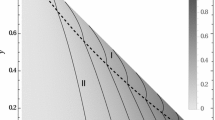Abstract
The coefficient matrix and local unitary (LU) transformation invariant of three-qubit states are studied in this paper. There is general relation between the coefficient matrix and independent LU transformation invariant existing which is shown. Especially, the three coefficient matrix can completely determine six algebraically independent local invariants for three-qubit pure states.
Similar content being viewed by others
Avoid common mistakes on your manuscript.
1 Introduction
Entanglement is known to be a promising resource which enables us to execute various quantum tasks such as teleportationquantum computing, quantum cryptography, etc. [1, 2]. With experimental technology development, multi-mode entanglement states based on noise correlation and squeezing of parametrically amplified multi-wave mixing literatures in atomic ensemble are achieved [3,4,5]. It is imminent of application of quantum entanglement, however, an important question for quantum information theory is how to determine if a given state is entangled. A common feature of entanglement for multipartite quantum systems is that the non-local properties do not change under local transformations, i.e. the unitary operations act independently on each of the subsystems. Hence the entanglement can all be characterized by the invariants under LU transformations. Two quantum states are locally equivalent under LU transformations if and only if all these invariants have equal values [6]. Numerous researchers have investigated the equivalent classes of three-qubit states specified by LU transformation invariants [7,8,9]. Sudbery studied invariants of three-qubit states under LU transformations with polynomials. It has been shown that three-qubit pure states have six independent invariants [10]. With the six independent invariants, we can determine whether two three-qubit pure states are LU-equivalent or not.
In 2015, Li et al. have proposed a simpler and more efficient approach to the stochastic local operations and classical communication (SLOCC) classification of general n-qubit pure states in [11]. For two n-qubit pure states connected by SLOCC, Li proved that the ranks of the coefficient matrices are equal whether or not the permutation of qubits is fulfilled on both states. This theorem provides a way of partitioning all the n-qubit states into different families. Zhang et al. [12] has studied the invariants of arbitrary dimensional multipartite quantum states under local unitary operations. They give a set of invariants in terms of singular values of coefficient matrices of multipartite pure states and multipartite mixed states.
Recently, Zha et al. proposed the relation of SLOCC invariants and the character polynomial of the square matrix for three and four qubit states [13].
In this paper we give a set of invariants in terms of coefficient matrices of three pure states. Furthermore, the general relation between the coefficient matrix and independent LU transformation invariant is discussed.
2 The Definition of Coefficient Matrices for Three-qubit Pure States
An arbitrary pure state |ψ〉 of the three qubits A, B and C is expressed in the form of
For three qubit pure state, the coefficient matrix can be defined
3 The Six Algebraically Independent Local Invariants of Three Qubit Pure State
It is known [14,15,16] that there are six algebraically independent local invariants of three qubit pure state.
There is one independent invariant of degree 2,
The three linearly independent quartic invariants are
There is one independent invariant of degree 6
There is one independent invariant of degree 8, A convenient, and physically significant, choice is the 3-tangle identified by Coffman, Kundu and Wootters [9] :
We can show that τABC = |CAB| = |CAC| = |CBC|
where \(C_{AB}=\langle \psi ^{\ast }\left |\hat {\sigma }_{Ay}\hat {\sigma }_{By}\hat {\sigma }_{Cx}\right |\psi \rangle ^{2}+\langle \psi ^{\ast }\left |\hat {\sigma }_{Ay}\hat {\sigma }_{By}\hat {\sigma }_{Cz} \right |\psi \rangle ^{2}-\langle \psi ^{\ast }\left |\hat {\sigma }_{Ay}\hat {\sigma }_{By}\right |\psi \rangle ^{2}\)
From (1), one can obtain
Similarly, it is easy to show
4 The Relation of Local Invariants with Coefficient Matrices of Three Qubit Pure State
It is easy to show that
and \(2\left (1-I_{3}\right )=4Det\left (M_{B(AC)}M_{B(AC)}^{\dag }\right )\).
With
From [13],
where ν = iσy and σy are the Pauli operators.
we have
where ν = iσy and σy are the Pauli operators.
It is also easy to show that
Finally, we give the values of these invariants for some special states
For a factorized state
Then, we have
Therefore, \(M_{A(BC)}M_{A(BC)}^{\dag }=\left (\begin {array}{cc}0&0\\0&|a|^{2}+|b|^{2} \end {array}\right );M_{B(AC)}M_{B(AC)}^{\dag }=\left (\begin {array}{cc}|b|^{2}&0\\0&|a|^{2} \end {array}\right );\)
For a generalized GHZ state
Then, we have
Therefore, we have
For the W state
Using (2), we can also obtain
It is well know that the entanglement measure of qubits A, with the pair (BC) is \(\tau _{A(BC)}=2(1-I_{2})=4Det\left (M_{A(BC)}M_{A(BC)}^{\dag }\right )\)
Similarly,
Therefore, we can see those entanglement measure τA(BC), τB(AC),τC(AB),τABC, can be easy to obtain by coefficient matrices.
5 Conclusion
In the present paper, we have proposed three coefficient matrix for three qubit pure states, and the mathematical connection between independent LU transformation invariant and the coefficient matrices was established, which indicates that entanglement classification and quantification are closely linked to the coefficient matrices. Examples were discussed to show that the coefficient matrices is capable of dealing with three qubit pure states. We give six algebraically independent local invariants in terms of coefficient matrices. For instance, by means of the coefficient matrix, it can be easily to obtain entanglement measure of 3-tangle τABC. As these LU invariants can be explicitly calculated, our approach gives a simple way in verifying the LU equivalence of given three qubit pure states. We expect that our work could come up with further theoretical and experimental results.
References
Bennett, C.H., Brassard, G., Crepeau, C., et al.: Phys. Rev. Lett. 70, 1895 (1993)
Nielsen, M.A., Chuang, I.L.: Quantum Computation and Quantum Information. Cambridge University Press, Cambridge (2000)
Li, C.B., Jiang, Z.H., Zhang, Y.Q., et al.: Phys. Rev. A 7, 014023 (2017)
Zhang, D., Li, C.B., Zhang, Z.Y., et al.: Phys. Rev. A 96, 043847 (2017)
Abdisa, G., Ahmed, I., Wang, X.X., et al.: Phys. Rev. A 94, 023849 (2016)
Albeverio, S., Fei, S.M., Parashar, P., Yang, W.L.: Phys. Rev. A 68, 010303 (2003)
Acin, A., Andrianov, A., Costa, L., et al.: Phys. Rev. Lett. 85, 1560 (2000)
Acin, A., Andrianov, A., Costa, L., et al.: J. Phys. A: Math. Gen. 34, 6725 (2001)
Coffman, V., Kundu, J., Wootters, W.K.: Distributed entanglement. Phys. Rev. A 61, 2306 (2000)
Sudbery, A.: J. Phys. A: Math. Gen. 34, 643 (2001)
Li, X.R., Li, D.F.: Phys. Rev. Lett. 108, 180502 (2012)
Zhang, T.G., Zhao, M.J., Li, X.Q., Fei, S.M.: Int. J. Theor. Phys. 52, 3020 (2013)
Zha, X.W., Zhang, D., Wen, F., Zhang, Y.P.: Laser Phys. 29, 025203 (2019)
Linden, N., Popescu, S.: Fortschr. Phys. 46, 567 (1998)
Li, X.R., Li, D.F.: Phys. Rev. A 91, 012302 (2015)
Acn, A., Andrianov, A., Costa, L., et al.: Phys. Rev. Lett. 85, 1560 (2000)
Acknowledgements
This work is supported by the Shaanxi Natural Science Foundation under Contract No. 2017JQ6024.
Author information
Authors and Affiliations
Corresponding author
Additional information
Publisher’s Note
Springer Nature remains neutral with regard to jurisdictional claims in published maps and institutional affiliations.
Rights and permissions
About this article
Cite this article
Hu, Y., Che, J. The Three Coefficient Matrices can Completely Determine Six Algebraically Independent Local Invariants of Three-qubit States. Int J Theor Phys 59, 604–610 (2020). https://doi.org/10.1007/s10773-019-04353-8
Received:
Accepted:
Published:
Issue Date:
DOI: https://doi.org/10.1007/s10773-019-04353-8




